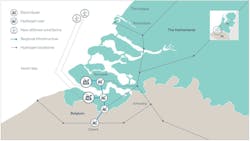North Sea wind farm, hydrogen production proposed for SeaH2Land project
Offshore staff
FREDERICIA, Denmark – Ørsted is looking to develop the offshore wind farm and electrolyzer for the SeaH2Land project for the Dutch-Flemish North Sea Port cluster.
This envisages construction of a regional cross-border pipeline transporting green electricity from renewable hydrogen produced offshore to large industrial companies in the region.
ArcelorMittal, Yara, Dow Benelux, and Zeeland Refinery are among those supporting development of the required infrastructure for sustainably-produced steel, ammonia, ethylene, and fuels that would help the Netherlands and Belgium reduce their carbon emissions toward 2030 and beyond.
Ørsted would develop a renewable, 1-GW hydrogen production facility by 2030. The electrolyzer producing the renewable hydrogen would convert about 20% of the current hydrogen consumption in the region to renewable hydrogen.
The company proposes to connect the electrolyzer directly to a new 2-GW offshore wind farm in the Dutch North Sea, ensuring the large-scale supply of renewable electricity required for production of renewable hydrogen.
The wind farm could be in one of the zones in the southern part of the Dutch exclusive economic zone already designated for offshore wind development, with the regional open-access pipeline network extending around 45 km (28 mi) across the North Sea Port area from Vlissingen-Oost to Ghent.
Yara, in consortium with Ørsted, and Zeeland Refinery have each announced plans for mid-size renewable hydrogen production at their sites, while Dow has been exporting hydrogen to Yara since 2018 through a gas pipeline converted to carry hydrogen.
The network could be extended farther south to ArcelorMittal and farther north, beneath the river Scheldt, to Zeeland Refinery. At the same time, the 380-kV HV network could be extended to cater for the electrification needs of the industry south of the river Scheldt.
That in turn would allow GW-sized electrolysis and offshore wind landing zones on both sides of the river.
The partners now plan dialogue with the regulatory authorities on the framework and policies needed to support the development of renewable hydrogen linked to large-scale offshore wind, the regional infrastructure, and to conduct a full feasibility study of the project.
03/31/2021



